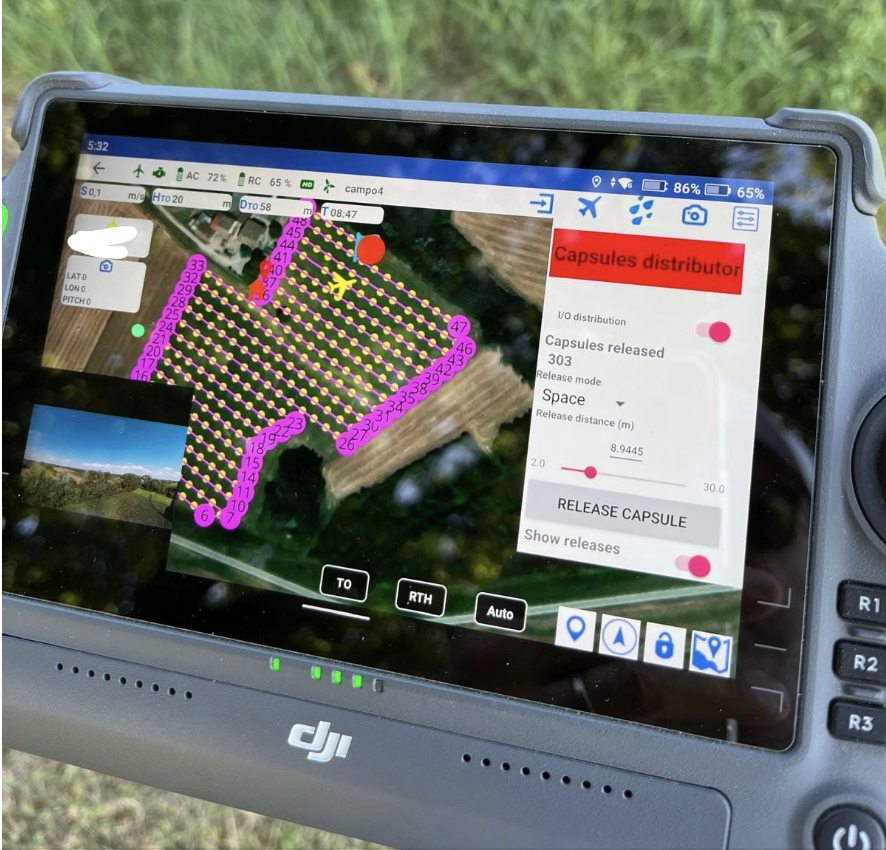
Interview with Roberto Buoli: How the Use of Aermatica3D Drones Revolutionizes Biological Control in Agriculture
Today we are with Roberto Remagni Buoli, from the Buoli Attilio di Remagni Silvio e C s.n.c. company, a company that has been contracting in the agricultural sector for almost eighty years. We had the chance to talk about drones and biological control of tomato spider mites and corn borers.
Aermatica3D: Can you tell us a little about yourself and how you met Aermatica3D?
Roberto Remagni Buoli: We are a company that does service contracting in agriculture. For ten years we have offered treatments on corn using the stilt. In 2016, tired of being in contact with the insecticide, we decided to stop. At Verona Agricultural Fair in February 2016 we saw a drone offering treatments against trichogram borer and we decided to try it on our plots. After two years of excellent results, we have obtained the necessary certificates to use a drone. In 2018, Marco Zambelli, CAI-Consorzi Agrari D’Italia agronomist, advised us to purchase Aermatica3D drones solutions. The General Manager of Aermatica3D, Eng. Paolo Marras, gave us a demonstration of the DJI Matrice 100 product with the D-Box capsule distribution kit and we immediately fell in love, a very precise, intuitive and simple to use system. From there it all started. In 2024, we upgraded to a DJI Matrice 350 with integration of Aermatica3D Agriculture Kits.
Aermatica3D: How long have you been working in the drone sector and how did you come to specialize in agricultural services?
Roberto Remagni Buoli: I have been working in the drone sector since 2018. The specialization in agricultural services was born from the need to find more effective and sustainable solutions compared to traditional methods.
Aermatica3D: What are the main benefits of using drones in biological control compared to traditional methods?
Roberto Remagni Buoli: The main benefits are respect for the environment and the absence of trampling of the ground, guaranteeing greater sustainability for the operator and the ecosystem.
Aermatica3D: Can you describe how the release of Trichogramma brassicae occurs via drones for corn borer control?
Roberto Remagni Buoli: The release of the Trichogramma is very simple with the Aermatica3D app. You arrive in the field, define the boundaries together with the farmer, enter the working parameters, fill the container and the drone does everything else autonomously.
Aermatica3D: What specific technologies and equipment do you use for this type of work?
Roberto Remagni Buoli: We use the M350 for its greater battery life and capacity. The Aermatica3D App, together with the distributor, guarantees precise work with georeferenced reports. Additionally, we are using the K-Kit for phytoseiid releases.
Aermatica3D: In terms of costs, how does the use of drones for biological control compare to manual or chemical methods?
Roberto Remagni Buoli: The use of drones is competitive in terms of costs, especially considering the reduction in foot traffic and the effectiveness of the release of biological agents without the use of chemicals.
Aermatica3D: How much time do you save using drones for the release of biological agents such as Trichogramma brassicae compared to traditional methods?
Roberto Remagni Buoli: With the M100 I was able to cover 100 hectares in a day, while with the M350, thanks to the greater autonomy and capacity, we can reach 150 hectares a day without problems. We saved about 30% in costs compared to manual methods.
Aermatica3D: What feedback have you received from your customers on the effectiveness of biological control carried out with drones?
Roberto Remagni Buoli: The feedback was very positive. Customers appreciate the precision and effectiveness of biological agent delivery via drones, as well as the environmental benefits.
Aermatica3D: Can you share some results or success stories that demonstrate the effectiveness of this technology?
Roberto Remagni Buoli: A significant example was the success in controlling the corn borer over large areas, where we drastically reduced the infestation thanks to the precise and uniform release of Trichogramma brassicae.
Aermatica3D: What are the main challenges you have encountered in using drones for biological control?
Roberto Remagni Buoli: The main challenges were related to training and equipment management. However, with the experience and support of Aermatica3D, we managed to overcome them effectively.
Aermatica3D: How do you see the future of the use of drones in agriculture, in particular for the biological fight against parasites such as the red tomato spider mite and the corn borer?
Roberto Remagni Buoli: The future of the use of drones in agriculture is very promising. Technology will continue to evolve, offering increasingly efficient and sustainable solutions for fighting biologists.
For more informations, contact us at info@aermatica.com

